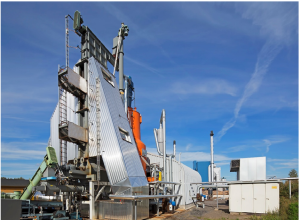
Torrefaction is a promising technology for the pre-treatment and refining of solid biomass, it is currently close to the commercialization phase and has attracted the interest of many developers and large scale users. Typically, the torrefaction process is a thermal treatment of biomass, in a temperature range between 200-300° C, in absence of oxygen and with a variable residence time (around 1 hour). The biomass gets roasted during the process and releases various volatile compounds. The final solid product has a higher energy density, better storability and better grindability than wood pellets or woodchips. For these reasons it can be used as a valuable renewable feedstock for co-combustion in small percentages in coal power plants, or it can be used in higher percentages in coal fired combined heat and power plants, hence the name biocoal. Currently around 60 companies globally are developing and testing different technologies for biomass torrefaction and around 10 demo or first commercial units are already in operation or under construction.
A study conducted by the Lappeenranta University of Technology and the Mikkeli University of Applied Sciences, evaluated the quality characteristics of biocoal pellets produced at the Torrec Ltd. pilot plant, located in Mikkeli, eastern Finland. The study also estimated the cost competitiveness of biocoal production at full scale. The Torrec plant has a nominal capacity of 10,000 tons per year and is based on a vertical reactor, where biomass material flows by gravity. Torrefaction occurs by steam inertization and through an accurate process control. Wood chips are conveyed from a chip silo to the unit where all the phases of torrefaction take place: pre-drying, post-drying, torrefaction, and cooling of solids. After this step, the biomass is delivered to a pelletizing unit and packed in big bags of 1 m3.
Several different woody biomass feedstock were tested: forest chips made from coniferous trees (spruce, pine) and broadleaf (birch), as well as by-products such as bark. Results showed that the quality of torrefied pellets depends to a large extent on the quality of raw material, the particle size distribution should be as homogenous as possible and fine particles should be avoided. No binders were used in the pelletization phase, and this is an advantage as binders concur to increasing the production costs. The lower heating value of the biocoal pellets varied between 17.96 and 18.44 MJ/kg (4.99–5.12 kWh/kg) with an initial moisture content of 6.57%. Higher energy density and lower moisture are expected with new continuous process tests which will be conducted at a higher temperature and with a separate drying system. Biocoal is typically hydrophobic, however, trials with outdoor covered storage during winter revealed a slight increase in the moisture content of the torrefied pellets.
Biocoal cost estimates
Since the majority of plants is still in the pilot stage, estimating the final production cost of torrefied pellet is not an easy task, nevertheless, this study indicated a cost of 208 €/ton, or 37–39 eur/MWh, for a full scale 50 kton/y plant. Several different factors can affect the final production cost of torrefied pellets. In the conditions considered by the study, raw-material accounted for 57% of the final production cost, while the torrefaction process accounted for 33%, and transport for 10%. This price level is clearly higher than the current price of coal used in combined heat and power plants, around 26 eur/MWh in Finland, however 1.2 million tons of torrefied pellets could replace half of the coal used in CHP plants in Finland annually.
For this reason the authors suggest there is a need for a subsidy system, such as feed-in tariffs, to make energy from biocoal competitive in the current market conditions. On the other hand, process improvements and economies of scale could significantly help in lowering the final production cost of biocoal. In addion to these, process integration into the existing forest industry could also be an effective way to reduce production costs, for example by utilizing the by-products available at sawmills or plywood mills, and by taking advantage of the wood procurement logistics available at forest industry plants. In similar estimations conducted by the European project SECTOR, the production cost of torrefied pellets was evaluated as low as 33 €/MWh in existing modern pulp mills. This value is not too far from the average price of wood pellets in the Baltic region, which are priced at around 30 €/MWh at the PIX index.
At the European level the main market for biocoal remains the one of pulverized coal-fired power plants, which currently use wood pellets for co-firing. However, using wood pellets needs additional investments by power plants, in order to be suitable for co-combustion in relatively high percentages, while biocoal pellets could be used as such in many of the the existing plants, thus allowing for significant savings in capital costs.
This post is based on the paper “Demonstration of Handling and Logistics of Torrefied Pellets” by T. Ranta, J. Foer and H. Soininen presented at the 23rd European Biomass Conference and Exhibition.
Click here for the full paper and slides.


